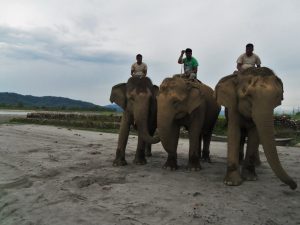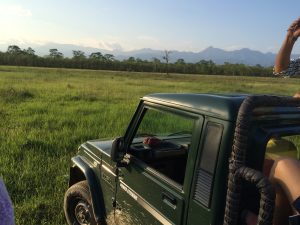
Week Two
By Rachel Hudgens
Attempts Dorothy impression: rhinos, and elephants, no tigers, oh my! My second week in Nepal seemed to be geared more towards conservation and livelihoods. During the more hands-on portions of the week I found myself seeing several endangered one-horned rhinoceroses, having very close interactions with Asian elephants and taking in beautiful scenery of the terai (the lowlands).
One reoccurring theme throughout this week was the ethics of owning and training elephants. There were many emotions within the group while we were riding through the buffer zones on elephants. The mahouts would use prods and sticks to direct the animal where to go. For some it was difficult to watch how the elephants were being treated, it also depended on what trainer you were with. Personally, I had already seen how elephants are trained when I went on a trip to South Africa. It’s hard to say that the harsh treatment didn’t impact me, but the methods used were not a surprise to me.

The group questioned why it was necessary for people to own and train elephants. From an outsider’s perspective it seemed like the elephants were being mistreated. We later learned how much it takes to care for these mammals. The relationship between the elephants and the mahouts is all about give and takes. The elephants help with farming, transportation and tourism. The trainers feed them, help preserve the endangered species and care for them. One thing that really impacted me was seeing the mahouts bathe the elephants. The group was able to partake in this activity too.
 Although during our elephant rides it seemed as though the treatment of the elephants was harsh, we found out that an elephant’s skull is very thick. Between the thick skull and leathery skin, the techniques used to control the pachyderms really doesn’t hurt them as much as we imagine.
Although during our elephant rides it seemed as though the treatment of the elephants was harsh, we found out that an elephant’s skull is very thick. Between the thick skull and leathery skin, the techniques used to control the pachyderms really doesn’t hurt them as much as we imagine.

